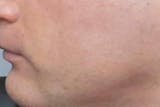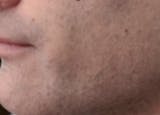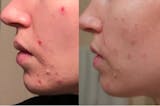Learn how to identify the different types of eczema
Discover the treatments that work for the eczema type
There are three pillars to healthy skin: a functional skin barrier, calm immune system and a safe environment. If any one of these pillars is disrupted, this can lead to inflamed skin, known as dermatitis or eczema.
There are different types of eczema but they are all characterized by areas of inflamed, itchy and dry skin. The different types of eczema can have different triggers and underlying issues with skin barrier strength and immune reaction. Identifying which type of eczema is present can help determine the best course of action to heal quickly and to prevent new flares.
This article steps through the different types of eczema, exploring the typical symptoms and triggers.
JUMP TO SECTION:
Atopic Dermatitis
Atopic dermatitis eczema, also known simply as atopic eczema (and often what people refer to as "eczema"), is the most common form of eczema, affecting around 10-20% of children and 1-3% of adults worldwide. This chronic inflammatory skin condition is characterized by periods of flare-ups and remissions, and is often associated with other atopic conditions like asthma and hay fever.(CHA 2006)
Symptoms
The symptoms of atopic dermatitis can vary greatly from one individual to another, and may also change over time. Mild symptoms include small patches of dry, itchy and cracked skin. In moderate to severe symptoms, the skin can become inflamed and subsequently change color. For more, check out our article on the symptoms of eczema.
With the skin inflamed, it is even easier for triggers to pass through the barrier and perpetuate the flare. We cover more details on the lifecycle of a flare is our article on the stages of a flare.
Causes and Risk Factors
Atopic dermatitis patients typically have a genetic predisposition for a weakened skin barrier, and as a result they are more susceptible to triggers.(BRO 2017) A deficiency in long chain ceramides is gerenally part of the weakened skin barrier of those with atopic eczema. The weakened skin barrier and increased inflammation tends to lead to drier skin and an imbalanced microbiome.(JAN 2012)
Atopic eczema tends to form on certain parts of the body that undergo a lot of movement or have thinner skin, including, but not limited to, the knee and elbow creases and around the neck and ankles. Atopic eczema will often appear symmetrically on the body i.e. if one hand is affected, it is likely that the other hand will also be affected. These areas can be dry and itchy and the symptoms can be significantly worse after exposure to the individual’s triggers.
In severe cases, the eczema can spread across the whole body and cause extreme discomfort. In babies, it often forms on the neck and scalp, the nappy region is normally unaffected.(CHA 2006)
Treatment Options
For a comprehensive overview of the treatment options for atopic dermatitis eczema, please visit our article on treatment.
Contact Eczema
Contact eczema, also known as contact dermatitis. This is a type of eczema that occurs when the skin comes into contact with certain substances that cause irritation or trigger an allergic reaction.
It was estimated that contact eczema affects around 15-20% of the population at some point in their lives, making it a relatively common skin condition.
Causes of Irritant Contact Eczema
Irritants cause physical damage to the skin. When in contact, there is no response from the immune system. Examples of irritants are: soaps, detergents, solvents and acid/alkaline solutions.
Symptoms can range from mild dryness to severe cracked and inflamed skin. It is most commonly found on the hands since the hands come into contact with more substances more regularly.
Causes of Allergic Contact Eczema
Allergic contact eczema is less common than the irritant form. The immune system reacts to the skin coming into contact with specific allergens.
Even small amounts of the allergen can cause a severe reaction with red itchy inflammation, dry skin, hives and blistering. Mild cases can appear with scaling of the skin and mild redness.
Symptoms
Both types of contact eczema result in redness and inflammation of the skin followed by dryness with itchiness throughout. The inflammation can affect the skin color where lighter skin can appear more red and darker skin can appear darker, more purple or grey.(NHS)
In some cases, little raised red lumps can appear in the affected site or the skin can thicken. The triggers and appearance of contact eczema can be similar to atopic dermatitis however, there are differing characteristics.
Contact eczema primarily affects only the area of skin which has come into contact with the trigger. Allergic contact eczema can spread beyond this area but it may not be symmetrical, like atopic eczema often is.(CHA 2006)
Treatment Options
The primary goal of contact eczema treatment is to identify and avoid the irritant or allergen causing the reaction. In addition, various topical and oral medications may be prescribed to reduce inflammation and relieve itching.
Seborrheic Eczema
“Seborrheic” means greasy or oily, and this type of eczema generally forms in regions of skin with high natural grease (sebum) production. A fairly common type of eczema with around 50% of the population having a non-inflammatory form of Seborrheic eczema. Generally, this type of eczema is mild and rarely leads to serious complications.(WHO 2017)
Symptoms
In children, it primarily affect the scalps and creases. For babies, this is also called “cradle cap”, where the head crusts up with yellow greasy scales. It can develop around the nose, forehead, eyebrows, behind the ears in nappy areas and armpits. In these areas, it appears as red, inflamed and glistening, and sometimes oozing dries into crusting.
In adults, the condition can affect any age and gender however it is most common in men and in young to middle-aged adults. It can start as dandruff on the scalp before spreading to the face and neck. Commonly affected areas are: forehead, ears, eyebrows, eyelids and folds alongside the nose. Here, the skin appears yellowed with small flakes of skin and occasional crusting. Other areas which can be affected include the back, armpits, groin or under breasts.
Causes and Risk Factors
The exact cause of seborrheic eczema is not well understood, but it is believed to involve a combination of genetic and environmental factors.
A common contributing factor is an overgrowth of the yeast Malassezia, which is naturally present on the skin but can cause inflammation in susceptible individuals. Other risk factors include stress, cold weather, and certain medical conditions, such as HIV and Parkinson's disease.
Treatment Options
Treatment for seborrheic eczema focuses on managing symptoms and controlling the growth of Malassezia yeast. This may involve the use of medicated shampoos, topical antifungal creams, and corticosteroids to reduce inflammation and itching.(CHA 2006)
It is important to work with a healthcare professional to develop an individualized treatment plan.
Nummular Eczema/Discoid Eczema
Nummular eczema, also known as discoid eczema, is a less common form of eczema characterized by round or oval-shaped patches of irritated skin. This condition affects both men and women, with a higher prevalence in middle-aged and older adults.
The exact prevalence of nummular eczema is unclear, but it was estimated to account for approximately 2% of all eczema cases.
Symptoms
The main symptoms of discoid eczema are disk-like patches around an inch in diameter (25 mm). The patches are itchy, red and bumpy and most commonly found on the legs and arms.
In severe cases, the skin can become very inflamed with oozing and crusting.(NHS) As the problematic area heals, the skin dries over and become scaly.
Causes and Risk Factors
While the exact cause of nummular eczema remains unknown, it is thought to be triggered by a combination of genetic and environmental factors.
Common risk factors include dry skin, skin injuries, and exposure to irritants. Individuals with a history of atopic conditions may also be at an increased risk of developing nummular eczema.
Treatment Options
Treatment is similar to atopic eczema but the trigger of discoid eczema is unclear.(MCW 2022) The patches might clean completely only to return time and time again.(CHA 2006) Therefore treatment for nummular eczema is focused on managing symptoms and preventing flare-ups. This may involve the use of topical corticosteroids, moisturizers, and antihistamines.
In more severe cases, healthcare professionals may prescribe oral medications or other therapies.
Dyshidrotic (Pompholyx) Eczema
Dyshidrotic eczema, also known as pompholyx eczema, is a type of eczema that is characterised by clear-fluid blisters on the hands and/or feet.(NHS) This relatively rare condition accounts for approximately 5-20% of all hand dermatitis cases and affects both men and women, with a higher prevalence in individuals aged 20-40 years.
For most affected (80%), the eczema forms on their hands and not on their feet.
Symptoms
The characteristic symptoms of dyshidrotic eczema include small, fluid-filled blisters that can be intensely itchy and painful. Their size can range from a few mm to a few cm and are often densely packed.
The affected skin is extremely itchy. The blisters can take 2 to 3 weeks to clear where the skin will appear red, scaly and often cracked.
The symptoms can return within a few weeks or months and this can repeat for months or years.(CHA 2006)
Causes and Risk Factors
The cause is not often known, but atopic dermatitis, exposure to contact allergens and/or irritants, hyperhidrosis, smoking, exposure to ultraviolet light, and intravenous immunoglobulin use or mycosis (disease from fungal infection) can be considered as suspects for its occurrence.(SAR 2020)(NHS) Some cases seem to be spontaneous with no apparent trigger.(GUI 2017)
Treatment Options
Treatment for dyshidrotic eczema focuses on managing symptoms and preventing flare-ups. This may include the use of topical corticosteroids, cold compresses, and antihistamines.
In more severe cases, healthcare professionals may prescribe oral medications or other therapies.
Asteatotic Eczema
Asteatotic eczema is also known as “eczema craquelé” or “winter eczema”, It is a type of eczema that primarily affects older adults, particularly those over the age of 60.
This condition is characterized by dry, cracked, and scaly skin, and is more common during the winter months when the air is drier.
Symptoms
The affected skin is rough, scaly, reddish, sore and itchy. The scales form a criss-cross pattern, similar to a dried river bed. Commonly affected areas include: thighs, arms, stomach and back. It’s uncommon to have blistering with this type of eczema. Symptoms can last for weeks to months.(SPE 2022)
Causes and Risk Factors
Asteatotic eczema is primarily caused by a reduction in the skin's natural oils, leading to increased water loss and dryness. This can be exacerbated by factors such as low humidity, harsh soaps, and frequent bathing.
Treatment Options
The primary goal of asteatotic eczema treatment is to restore and maintain the skin's moisture levels. This may involve the use of gentle cleansers, moisturizers, and topical corticosteroids to reduce inflammation and itching.
Life-style changes can improve the skin health and it often responds well to milk-treatment.(CHA 2006) It is important to work with a healthcare professional to develop an individualized treatment plan.
Gravitational Eczema
Gravitational eczema is also known as “stasis” or “varicose eczema”. This condition is the result of fluid building up in the legs and subsequently affects the skin of the lower legs. The veins are essential for pumping blood back up to the heart.
If this system is not working properly, perhaps due to age, blood clots or being overweight, the pressure can cause fluid to collect in the skin.
Symptoms
Ankle may swell, and skin can weep or ooze. The skin looks shiny, discoloured and itchy and eventually can become leathery and thickened. On lighter skin, it can appear red whereas darker skins can appear darker or more purple or grey.(NHS)
Blotches of brown can indicate that blood has also leaked into the skin and this is often found on the inside of the ankles. This condition can spread up the legs if it is not controlled.
The symptoms will persist until the cause of the increased pressure is released.(CHA 2006)
Causes and Risk Factors
Gravitational eczema is primarily caused by poor blood flow and increased pressure in the veins of the lower legs. This leads to fluid leakage into the surrounding tissues, resulting in inflammation and eczema.
Risk factors for gravitational eczema include obesity, sedentary lifestyle, and a history of circulatory problems.
Treatment Options
Treatment for gravitational eczema aims to improve circulation in the affected areas and manage the symptoms of eczema. This may involve the use of compression stockings, elevation of the legs, and topical corticosteroids to reduce inflammation and itching.
In some cases, additional treatments may be required to address the underlying circulatory issues.
Know Your Personal triggers
Once you have identified which type of eczema you have, it is possible to identify your personal triggers and learn what is necessary to help your skin heal. For more information about potential triggers, see the triggers page. To learn how your lifestyle and subsequently your immune system affect your skin health in the section on immune control. There are various treatments available for eczema, learn more in the treatment section.



